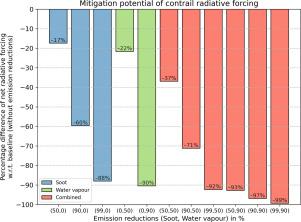减少烟灰和水蒸气排放量低的机队的尾迹辐射影响
IF 3.4
Q2 ENVIRONMENTAL SCIENCES
引用次数: 0
摘要
除了二氧化碳净零排放的目标外,减少航空对气候的影响还涉及解决其他强迫效应,特别是尾迹的辐射强迫。目前的理解表明,减少飞机发动机的烟灰和水蒸气排放可以减少飞机尾迹的发生和持续时间,从而降低其辐射强迫。这可以通过将废气中的水回收与颗粒冲洗相结合的发动机概念来实现。本研究使用尾迹卷云预测(CoCiP)模型进行了理想化的敏感性分析,以评估烟灰数量和水蒸气排放的减少如何影响欧洲上空尾迹卷云的辐射影响。排放情景与任何特定的发动机设计无关,而是为了探索尾迹形成和辐射效应的物理敏感性。排放的烟灰颗粒数量减少了两个数量级,水蒸气排放量减少了一个数量级。我们发现,减排量越大,减缓效应越明显。虽然这两个因素都有助于整体减排,但它们的结合会产生更强的效果。影响的大小取决于它们在尾迹形成过程中的相互作用和随后的大气过程。辐射强迫响应表现出明显的地理变异性,在冰过饱和气团频繁出现的地区影响最强。尾迹发生的日变化和季节变化以及辐射影响进一步调节了总体缓解潜力。模拟表明,如果在广泛的船队中应用降低烟灰和水蒸气排放的技术,尾迹辐射效应将大大减少。本研究的一个局限性是没有考虑其他尾迹成核途径,如挥发性颗粒上的凝结。因此,我们的评估可以提供烟灰和/或水蒸气排放减少尾迹卷辐射影响的上限。本文章由计算机程序翻译,如有差异,请以英文原文为准。

Reduced contrail radiative effect for fleets with low soot and water vapour emissions
Besides the goal of net-zero carbon dioxide (CO) emissions, reducing aviation’s climate impact also involves addressing other forcing effects, particularly radiative forcing from contrails. Current understanding suggests that decreasing both soot and water vapour emissions from aircraft engines reduces the occurrence and persistence of contrails, thereby lowering their radiative forcing. This may be achieved by engine concepts that combine water recovery from the exhaust with particle washout. This study presents an idealized sensitivity analysis using the Contrail Cirrus Prediction (CoCiP) model to assess how reductions in soot number and water vapour emissions could affect the radiative impact of contrail cirrus over Europe. The emission scenarios are not tied to any specific engine design but are chosen to explore the physical sensitivity of contrail formation and radiative effects. The number of emitted soot particles is reduced by up to two orders of magnitude, and water vapour emissions by one. We find that the mitigation effect becomes more pronounced with higher emission reductions. While both components contribute to the overall reduction, their combination leads to a stronger effect. The magnitude of the effect depends on their interactions during contrail formation and on subsequent atmospheric processes. The radiative forcing response exhibits marked geographic variability, with the strongest effects over regions with frequent ice-supersaturated air masses. Daily and seasonal variations in contrail occurrence and radiative impact further modulate the overall mitigation potential. The simulations indicate a substantial decrease in contrail radiative effect if technologies that lower soot and water vapour emissions are applied across a broad fleet. A limitation of this study is that other contrail nucleation pathways, such as condensation on volatile particles, are not considered. Thus, our assessment may provide an upper bound on the reduction of contrail cirrus radiative impact from soot and/or water vapour emissions.
求助全文
通过发布文献求助,成功后即可免费获取论文全文。
去求助
来源期刊

Atmospheric Environment: X
Environmental Science-Environmental Science (all)
CiteScore
8.00
自引率
0.00%
发文量
47
审稿时长
12 weeks
 求助内容:
求助内容: 应助结果提醒方式:
应助结果提醒方式:


